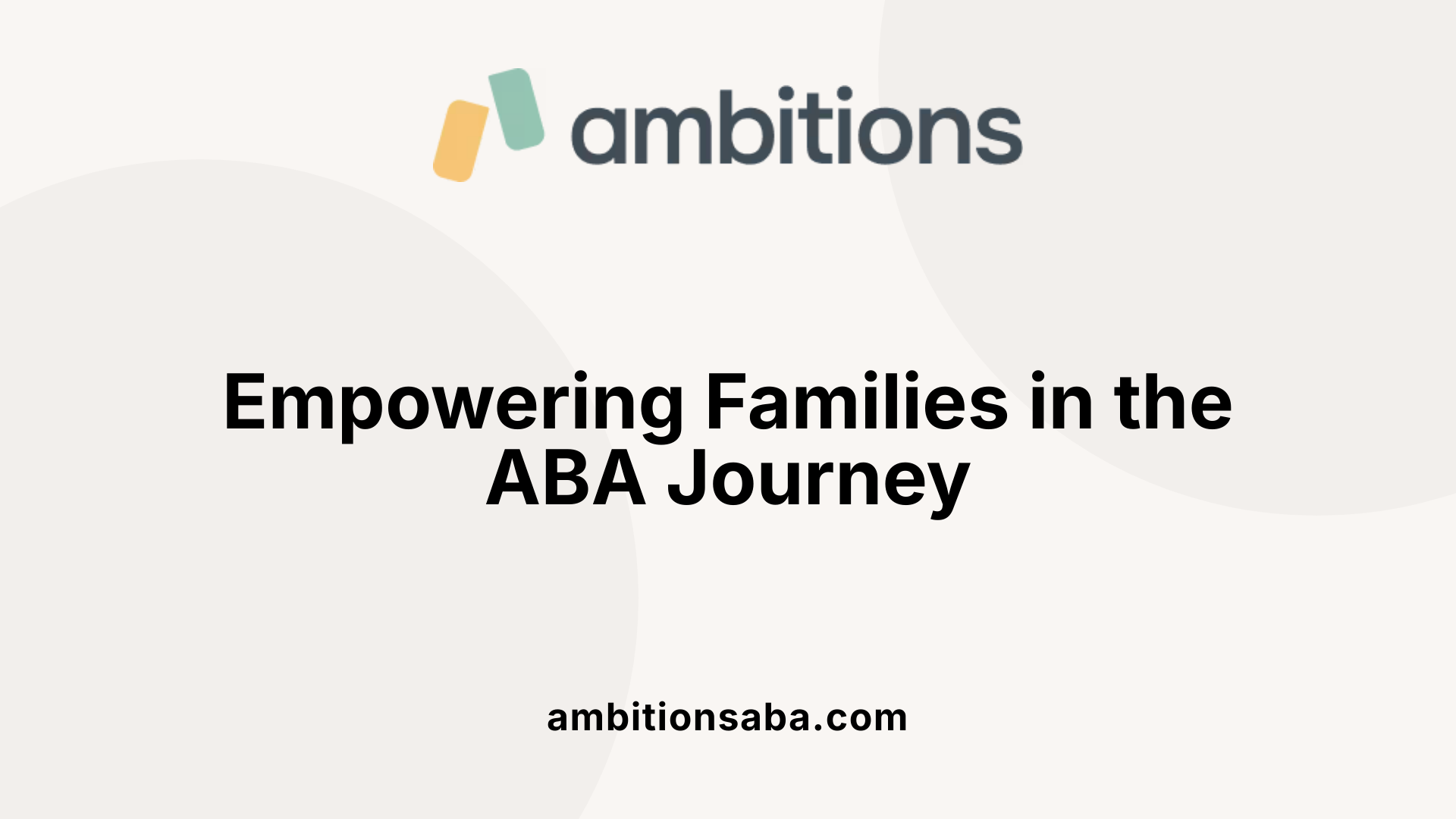Enhancing ABA Therapy with Video Modeling Techniques
Understanding ABA Therapy in Autism Care
Applied Behavior Analysis (ABA) therapy is a foundational, evidence-based approach widely recognized for its effectiveness in supporting children with autism spectrum disorder. This therapy uses the science of learning and behavior to foster essential skills such as communication, social interaction, and self-care, while reducing behaviors that may interfere with daily functioning. Given its individualized nature and focus on practical skill-building, ABA is uniquely suited to assist children navigating complex emotional experiences, including grief and loss.
What is ABA Therapy and How is it Used in Autism Treatment?
What is applied behavior analysis (ABA) therapy and how is it used in autism treatment?
Applied Behavior Analysis (ABA) therapy is a science-based approach centered on understanding how behavior works and how it is influenced by the environment. ABA aims to increase helpful behaviors, such as communication and social skills, while decreasing harmful or interfering behaviors.
Definition of ABA therapy
ABA therapy applies the principles of learning and behavior to teach essential life skills and manage behaviors. Evidence-based interventions include strategies like positive reinforcement, where desirable behaviors are encouraged using rewards, and the analysis of antecedents, behaviors, and consequences (known as the ABCs).
Use of ABA in autism treatment
ABA therapy is widely recognized as an effective treatment for children with autism. It helps improve communication, social skills, attention, memory, academic abilities, and daily living functions. The therapy also tailors strategies to address challenges related to ASD, such as sensory sensitivities and emotional regulation.
Key components of ABA programs
ABA programs are individualized and designed by behavior analysts (Board Certified Behavior Analysts or BCBAs). They conduct comprehensive assessments to set tailored goals broken into small, concrete steps. Ongoing data collection and progress monitoring allow adjustments to optimize treatment effectiveness. Techniques may include discrete trial training, naturalistic interventions, visual supports, social stories, and role-playing.
Settings for ABA therapy delivery
ABA therapy is flexible and can be delivered in homes, schools, and community settings. This adaptability helps children apply skills across environments, promoting generalization and independence.
Evidence supporting ABA effectiveness
ABA is endorsed by respected bodies like the US Surgeon General and American Psychological Association as an evidence-based best practice. Research shows that intensive long-term ABA therapy (25-40 hours weekly over 1-3 years) leads to significant improvements in intellectual functioning, language development, daily living, and social skills.
| Aspect | Description | Importance |
|---|---|---|
| Science-Based Approach | Uses principles of learning to increase helpful behaviors | Ensures intervention is grounded in proven methods |
| Individualized Programs | Customized goals with continuous assessment | Tailors therapy to each child's unique needs |
| Settings | Delivered at home, school, or community | Supports skill generalization and consistency |
| Reinforcement | Positive reinforcement encourages desirable behaviors | Motivates and shapes lasting behavior change |
| Evidence of Effectiveness | Supported by research and professional organizations | Validates ABA as a preferred autism treatment |
The Professionals Behind ABA Therapy

Roles of BCBAs and RBTs
ABA therapy is delivered by trained professionals with specific roles. Board Certified Behavior Analysts (BCBAs) design and oversee individualized treatment plans based on thorough behavioral assessments. Registered Behavior Technicians (RBTs), under BCBA supervision, implement therapy sessions directly with children to help them develop communication, social, and coping skills.
Service-delivery Model
ABA services typically follow a tiered model: BCBAs evaluate and create plans; RBTs provide hands-on therapy; and assistant analysts support assessment and data collection. This collaborative approach allows for tailored interventions that address the unique needs of each child.
Settings of Therapy Provision
ABA therapy can be delivered in multiple environments depending on the child's needs and goals. Common settings include the child’s home, school, and community spaces. This flexibility supports generalization of skills across daily routines and real-world situations.
Collaboration with Families
Parents and caregivers play an integral role throughout ABA therapy. Providers work closely with families to ensure programs respect individual preferences, maintain routines, and promote the child's independence. Training and communication help families reinforce learning and address behavioral challenges at home.
Ethical and Evidence-based Practices
Professionals adhere to ethical standards and rely on evidence-based methods such as positive reinforcement, behavioral analysis (focusing on antecedents, behaviors, and consequences), and data-driven adjustments. These practices have been endorsed by leading organizations and help optimize outcomes while safeguarding the child's well-being.
Primary Goals of ABA Therapy for Children with Autism

What are the primary goals of behavioral analysis therapies for autism?
The primary goals of behavioral analysis therapies, particularly Applied Behavior Analysis (ABA), focus on enhancing crucial skills and reducing challenges that children with autism may face. ABA aims to improve communication skills, enabling children to express needs and interact effectively through methods like teaching language, picture exchange systems, sign language, and augmentative alternative communication (AAC) devices.
Social skill development is another significant goal. ABA helps children navigate social situations, such as making friends or participating in group activities, and prepares them to handle specific events like funerals or conversations related to grief.
Behavior reduction is also a central aim. ABA targets challenging behaviors that may disrupt learning or daily life by understanding what triggers these behaviors and teaching effective coping strategies and self-regulation techniques.
Promoting independence in daily living is emphasized through skill-building in areas such as self-care, play, motor skills, and academic tasks. By breaking down these skills into small, manageable steps, ABA helps children become more self-sufficient and confident in everyday environments.
Lastly, ABA therapy relies heavily on comprehensive assessments to set personalized goals. A Board Certified Behavior Analyst (BCBA) designs individualized programs based on the child's unique strengths and needs. Progress is continually monitored using data collection, ensuring that therapy adapts as the child advances.
Together, these goals create a roadmap for supporting children with autism to thrive across homes, schools, and communities, improving their quality of life through evidence-based learning and behavior strategies.
Techniques Employed in ABA Therapy
What are the common techniques used in ABA therapy?
Applied Behavior Analysis (ABA) therapy uses various proven techniques to teach and reinforce desired behaviors in children with autism. One fundamental strategy is positive reinforcement, which encourages helpful behaviors by rewarding them, such as with praise, tokens, or preferred activities. This approach makes it more likely the behavior will occur again.
Discrete Trial Training (DTT) is another widely used technique. It involves breaking skills into small, manageable steps taught in a structured way. Each trial includes a clear instruction, the child's response, and immediate feedback or reinforcement. This method helps children learn skills systematically through repetition.
Modeling and prompting involve demonstrating the desired behavior for the child to imitate. Prompts might be physical, verbal, or gestural cues that guide the child toward the correct response. Prompts are gradually faded to increase the child’s independence.
Natural Environment Teaching (NET) focuses on teaching skills during everyday routines and play, making learning more meaningful and generalized outside structured sessions. ABA therapists work within the child’s typical surroundings to encourage skill use in real-life contexts.
Other behavioral strategies commonly used include behavior chaining, where complex behaviors are taught by linking smaller actions; extinction, which reduces unwanted behaviors by withholding reinforcement; behavior contracts to set clear expectations; and functional communication training, which replaces challenging behaviors with effective communication methods.
These techniques are tailored individually by Board Certified Behavior Analysts (BCBAs) to suit each child's unique needs and learning profile. The goal is to increase helpful behaviors and reduce interfering ones, ultimately helping children gain essential life and social skills.
| Technique | Description | Purpose |
|---|---|---|
| Positive Reinforcement | Rewarding desirable behaviors | Increase likelihood of helpful behaviors |
| Discrete Trial Training | Structured step-by-step teaching with reinforcement | Teach new skills systematically |
| Modeling and Prompting | Demonstration plus cues | Promote imitation and independence |
| Natural Environment Teaching (NET) | Teaching in real-life settings | Generalize skills to everyday life |
| Behavior Chaining | Linking smaller actions into a sequence | Teach complex behaviors |
| Extinction | Withholding reinforcement for unwanted behaviors | Reduce interfering behaviors |
| Behavior Contracts | Agreements defining expected behaviors and rewards | Clarify expectations and motivate behavior |
| Functional Communication Training | Teaching communication to replace problem behaviors | Improve communication and reduce challenging behaviors |
Effectiveness of ABA Therapy in Autism Spectrum Disorder
How effective is ABA therapy in treating autism spectrum disorder?
ABA therapy is a well-established, evidence-based approach proven to improve numerous skills in children with autism spectrum disorder (ASD). Research consistently supports its ability to enhance social, communicative, emotional, and daily living skills through systematic interventions.
Research evidence for ABA efficacy
Studies show that early and intensive ABA interventions—typically involving 25 to 40 hours per week over one to three years—can significantly boost intellectual functioning, language development, and social behaviors. Leading health organizations like the US Surgeon General and the American Psychological Association recognize ABA as a best practice treatment for autism due to this strong empirical support.
Benefits in language and social skills
ABA programs target critical areas such as communication skills, including the use of picture exchange systems, sign language, and augmentative and alternative communication devices. Emotion recognition, social skills training, and self-regulation strategies are embedded in therapy to develop effective interpersonal interactions and emotional coping, especially during stressors like grief.
Impact of early, intensive intervention
Early start and consistent, intensive therapy maximize developmental gains, helping children acquire essential life skills and reduce problem behaviors. Tailoring programs to individual needs increases the likelihood of positive outcomes, with supervision by Board Certified Behavior Analysts (BCBAs) ensuring skill assessment and goal-setting align with each child's unique profile.
Variability in outcomes
While many children experience meaningful improvements, outcomes can vary based on the quality of implementation, the child's specific needs, and therapy intensity. Programs often use data collection and ongoing assessment to adapt approaches, optimizing effectiveness and addressing emerging challenges.
Current emphasis on individualized and supportive approaches
Modern ABA emphasizes compassionate, individualized care that supports children in real-life settings such as home, school, and community. Techniques focus on positive reinforcement and incorporate visual supports, social stories, and role-playing to solidify learning. ABA also integrates coping strategies for sensitive periods, such as grief or major life changes, making interventions flexible and responsive.
| Aspect | Description | Impact |
|---|---|---|
| Research Evidence | Recognized by major health authorities as best practice | Validates ABA's reliability and effectiveness |
| Language & Social Skill Gains | Communication tools and emotional recognition skills integrated | Enhances interaction capabilities and emotional understanding |
| Early Intensive Intervention | Intense therapy hours tailored by professionals | Increases developmental progress and reduces maladaptive behaviors |
| Outcome Variability | Dependent on individual factors and therapy quality | Necessitates ongoing assessment and flexible program modifications |
| Individualized, Supportive Care | Use of positive reinforcement and real-life settings | Encourages independence and social participation with empathy and adaptability |
Tailoring ABA Therapy to Support Grief and Loss in Children with Autism

How is assessment individualized during grief in ABA therapy?
ABA therapists begin by conducting comprehensive and personalized assessments focused on the child's unique needs during grief. These evaluations inform the development of treatment plans that consider how loss affects the child's behavior and emotional state, ensuring interventions are directly relevant and supportive.
How does ABA address unique grief reactions in children with autism?
Children on the autism spectrum may experience grief differently, sometimes showing delayed or intensified responses. ABA therapy recognizes these variations by adapting strategies that include concrete explanations and visual supports to help children grasp abstract concepts like death or divorce. Tools such as social narratives, visual schedules, and memory books are used to clarify changes and provide comfort.
What coping skills programs are incorporated?
ABA sessions integrate specialized coping skills modules geared toward managing grief. These include emotion recognition techniques using visual supports and role-playing to help label feelings. Strategies for sensory regulation are also embedded to assist children in handling heightened sensitivities caused by grief. Moreover, self-regulation and emotional coping tactics are emphasized to address challenging behaviors that may arise.
How does ABA therapy adapt to emotional challenges related to grief?
The adaptability of ABA is demonstrated through tailored interventions that address emotional challenges in various settings — home, school, or community. Behavioral goals focus on enhancing communication through picture exchange systems, sign language, or AAC devices, enabling children to express grief-related emotions effectively. Maintaining routines and predictability adds a nurturing structure that fosters emotional security during difficult times.
What behavioral goals are specific to grief support?
ABA programs develop clear goals targeting social skills necessary for navigating grief-related situations such as funerals or conversations about loss. Instruction is broken down into manageable steps to teach appropriate social behaviors, emotional coping, and self-care. Continuous data collection ensures that progress is tracked and programs are adjusted to best meet the child's evolving needs during grief.
Communication Strategies in ABA to Help Children Cope with Grief

How Does ABA Use Picture Exchange Systems to Support Communication During Grief?
ABA therapy often incorporates picture exchange systems to help children with autism express their needs and emotions effectively. By using pictures, children who struggle with verbal communication can convey feelings related to grief, reducing frustration and promoting understanding.
What Role Do Sign Language and AAC Devices Play?
Sign language and Augmentative and Alternative Communication (AAC) devices are also valuable tools within ABA. These methods offer alternative ways for children to communicate complex emotions and thoughts about loss, tailored to their individual abilities and preferences.
How Is Emotion Recognition Taught?
Recognizing and labeling emotions is a central component of ABA therapy during grief counseling. Therapists use visual supports, such as emotion cards, alongside social stories that depict feelings linked to loss. This helps children identify their own emotions and understand those of others.
What Visual Supports and Social Stories Are Used?
Visual aids like social narratives and visual schedules guide children through the grieving process in a concrete, predictable manner. Social stories explain situations related to death or loss in simple, literal language, easing anxiety and confusion.
How Does Role-Playing Facilitate Emotional Understanding?
Role-playing activities are employed to practice expressing grief-related emotions and navigating social scenarios such as funerals or conversations about the deceased. This interactive approach fosters emotional coping skills and social readiness.
| Communication Strategy | Description | Benefits for Grieving Children with Autism |
|---|---|---|
| Picture Exchange Systems | Using images to communicate needs and feelings | Enhances expression when verbal skills are limited |
| Sign Language & AAC Devices | Alternative communication methods tailored to abilities | Enables complex emotion and thought expression |
| Emotion Recognition Teaching | Visual supports and social stories to label feelings | Builds emotional awareness and regulation |
| Visual Supports & Social Stories | Concrete explanations and schedules for grief-related events | Reduces anxiety through predictability and clarity |
| Role-Playing | Practicing social situations related to grief | Improves social skills and emotional coping |
Sensory and Behavioral Approaches in ABA for Grieving Children
How Does ABA Address Sensory Regulation in Grieving Children?
ABA therapy incorporates targeted sensory regulation strategies to help children with autism cope when grief heightens sensory sensitivities. These techniques often include personalized sensory activities designed to reduce overwhelm and provide calming input. Therapists use evidence-based methods adapted to each child's unique sensory profile, facilitating better emotional and behavioral control during difficult periods of loss.
What Techniques Help Manage Heightened Sensitivities During Grief?
ABA therapists use visual supports, structured routines, and calming sensory tools such as weighted blankets or noise-cancelling headphones to address sensory overload. These supports create predictability and comfort, enabling children to navigate emotional challenges without becoming overly reactive to sensory input.
How Does ABA Work to Reduce Challenging Behaviors Linked to Grief?
By conducting comprehensive assessments, therapists identify behaviors intensified by grief, such as agitation or withdrawal. ABA interventions focus on replacing these with adaptive behaviors through gradual skill-building and consistent positive reinforcement. Strategies include teaching emotional labeling and coping skills, which empower children to manage distress proactively.
What Self-Regulation Techniques Are Taught in ABA Therapy?
Children learn self-regulation through role-playing, emotion recognition exercises, and social stories. These activities help them identify feelings and practice appropriate responses. Techniques might involve deep breathing, seeking sensory breaks, or using communication aids to express needs, fostering independence in emotional management.
How Is Positive Reinforcement Utilized to Support Grieving Children?
Positive reinforcement remains central in ABA by encouraging desirable behaviors related to grief coping. Therapists systematically reward behaviors like using communication tools or successfully employing calming strategies. This approach motivates children to repeat helpful actions, gradually improving their adjustment to grief-related challenges.
Social Skills Training for Grief-Related Situations
Preparing for Social Events Like Funerals
ABA therapy helps children with autism prepare for social events such as funerals by using social narratives and visual schedules. These tools break down event details into manageable, concrete steps, helping kids understand what to expect and reducing anxiety about unfamiliar situations.
Practicing Conversations About Loss
ABA interventions include practicing conversations related to grief. Through role-playing and scripted dialogues, children learn how to express their feelings and respond to others' emotions. This approach builds confidence in handling discussions about death or loss.
Use of Social Narratives and Visual Schedules
Social stories and visual schedules are key components used by ABA practitioners to make abstract concepts like death clearer. These aids use concrete language and pictures to explain the sequence and expectations of grief-related events, supporting comprehension for children with literal language processing.
Memory Books for Remembrance
Memory books serve as tangible tools to help children remember and talk about loved ones who have passed. ABA therapists encourage creating these personalized books, which can foster emotional expression and serve as comforting aids during times of grief.
Helping Children Navigate Complex Social Emotions
Through emotion recognition techniques using visual supports and role-playing, ABA therapy teaches children to identify and label their complex feelings related to grief. This skill enhances emotional coping and aids in social interactions involving sensitive topics.
Together, these social skills strategies offer tailored support, empowering children with autism to navigate grief-related social situations more comfortably and effectively.
Supporting Families and Caregivers in Advocating for ABA During Grief

How can families and caregivers support ABA therapy for their loved ones with autism?
Families and caregivers play a crucial role in enhancing the effectiveness of ABA therapy for children with autism, especially during times of grief. Active involvement begins with participating in the development and follow-up of individualized treatment plans created by Board Certified Behavior Analysts (BCBAs) and Registered Behavior Technicians (RBTs). This includes reinforcing learned behaviors and coping strategies at home, ensuring consistency across environments.
Creating a nurturing home environment is essential. Consistent routines and predictability provide comfort and security to children navigating loss, helping regulate emotions and reduce anxiety. Visual supports like schedules and social stories can clarify daily expectations and explain difficult concepts related to grief, offering concrete understanding in a time of change.
Utilizing additional support services such as counseling or specialized therapists complements ABA by addressing emotional needs beyond behavioral goals. Open collaboration between families, ABA practitioners, and other providers ensures comprehensive care tailored to each child’s unique responses to grief.
Ultimately, families should foster positive reinforcement at home, celebrate small achievements, and maintain clear communication with professionals. This partnership not only empowers the child but also maximizes the benefits of ABA therapy across different life areas during challenging transitions.
Embracing ABA as a Compassionate Tool for Grieving Children with Autism
ABA therapy offers a scientifically grounded, flexible, and compassionate framework to support children with autism through the difficult experience of grief and loss. By individually assessing needs, teaching communication and coping skills, regulating sensory sensitivities, and fostering social understanding, ABA empowers these children to navigate loss with greater resilience and emotional clarity. Partnering with families and integrating complementary therapies enhances this support, enriching each child's journey toward healing and well-being. As awareness grows, ABA stands as a beacon of hope, providing tailored interventions that honor the unique ways children with autism experience and process grief.
References
- Discover Effective Applied Behavior Analysis in Riverside
- Autism and Grief: How to Support Your Child Through ...
- Applied Behavior Analysis (ABA)
- Supporting Individuals on the Autism Spectrum Coping with ...
- The effectiveness of applied behavior analysis program ...
- Applied Behavior Analysis (ABA)
- The Controversy Around ABA
- 6 Benefits of ABA Therapy for Children with Autism
- Applied Behavior Analysis (ABA)

